The document discusses the theoretical implications of a phase transition in quantum chromodynamics (QCD) between a hadron gas and a quark-gluon plasma, termed critical hadronization. By suggesting that hadronization is a critical phenomenon, it explores how renormalization group equations can offer insight into both high-energy hadronic reactions and confinement in QCD. The paper outlines a framework connecting topological expansions and dual models to improve understanding of particle interactions and hadron production in high-energy scenarios.




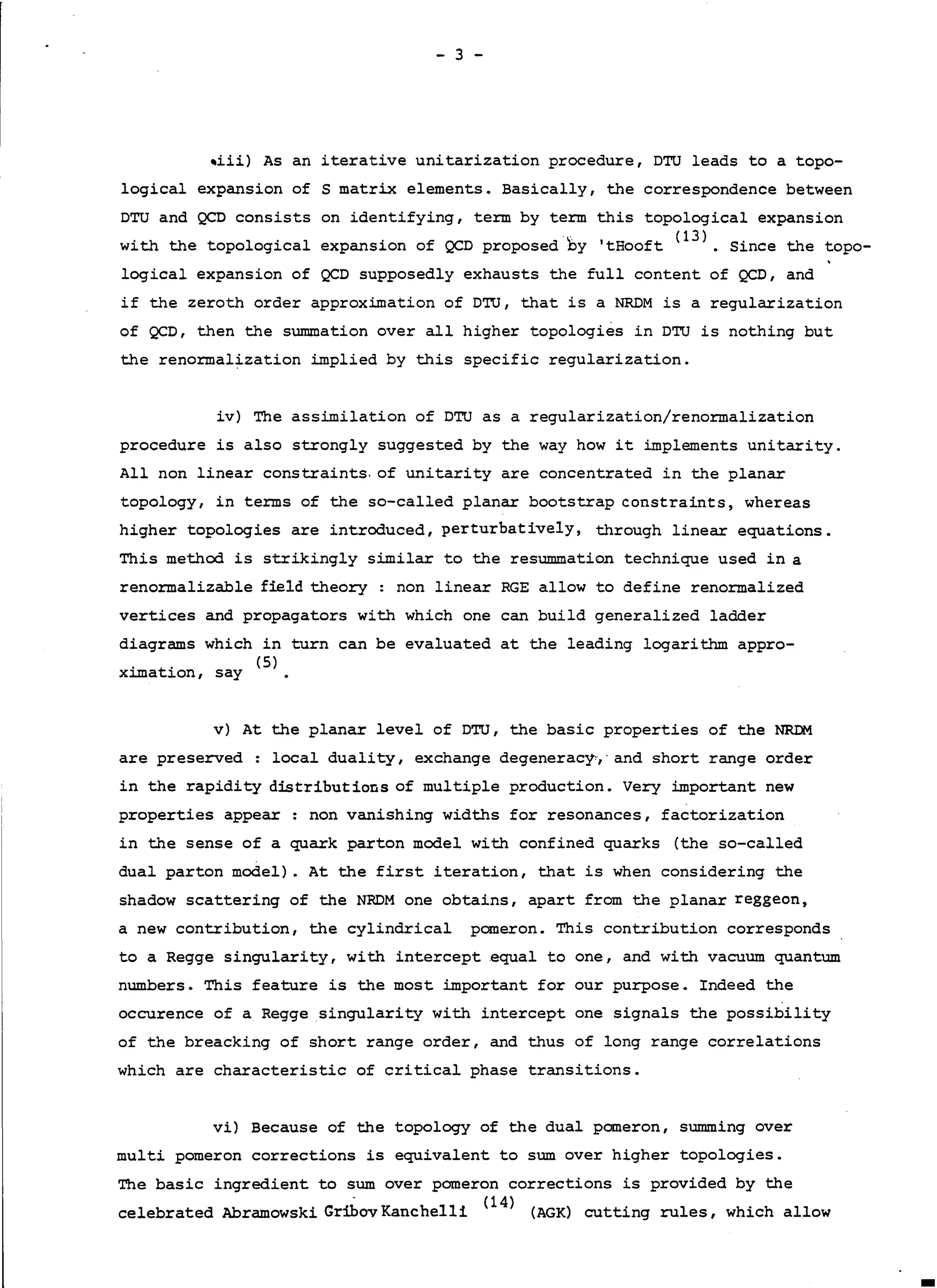

![- 5 -
I. PLANAR UNITARITY AND CRITICALITY
1. The topological expansion of QCD
The starting point of the correspondence between QCD and DTU is
the topological expansion of QCD. 'tHooft (l
3
) has shown that one can
rearrange the perturbation expansion of QCD in a way which exhibits the
topological properties of the two dimension manifold on which one can draw
the Feynman diagrams. One writes the n point Green's function as :
A
n
({P.})
l.
n
= g
-n
~,h,l,w
({P.})
l.
(1)
where {P.} denotes the set of external four momenta, N is the number of
l. C
colours, Nf the number of flavors. b,h,l and w are topological indices.bis
the number of boundaries, that is the number of closed loops to which external
particles are attached, h is the number of handles allowing internal propagators
to cross each other; 1 is the number of closed color loops and w the number
of closed flavor loops. The reduced amplitude ~n h
1
contains the full dyna-
b, ' ,w
mical information. To make more explicit the topological properties it is
useful to use a notation for quark and gluon propagators which exhibits their
color and flavor content (see fig. 1). This notation, when it is completed
t.:·,'
te include mesons, will be useful to identify the NRDM regularization of QCD.
--+---(.·····--> .•..... ,. or
==:::===c..C: ,,-, .......•..
_JL•• -·.>· .••.•.
_JL
,,
Fig. 1 : Two line representation of quark and gluon propagators. We use an axial
or n]anar aauae wbicb is.frPP of Fadp...ev_Ponov Gbasts.](https://image.slidesharecdn.com/criticalhadronization-190830091514/75/Critical-hadronization-7-2048.jpg)










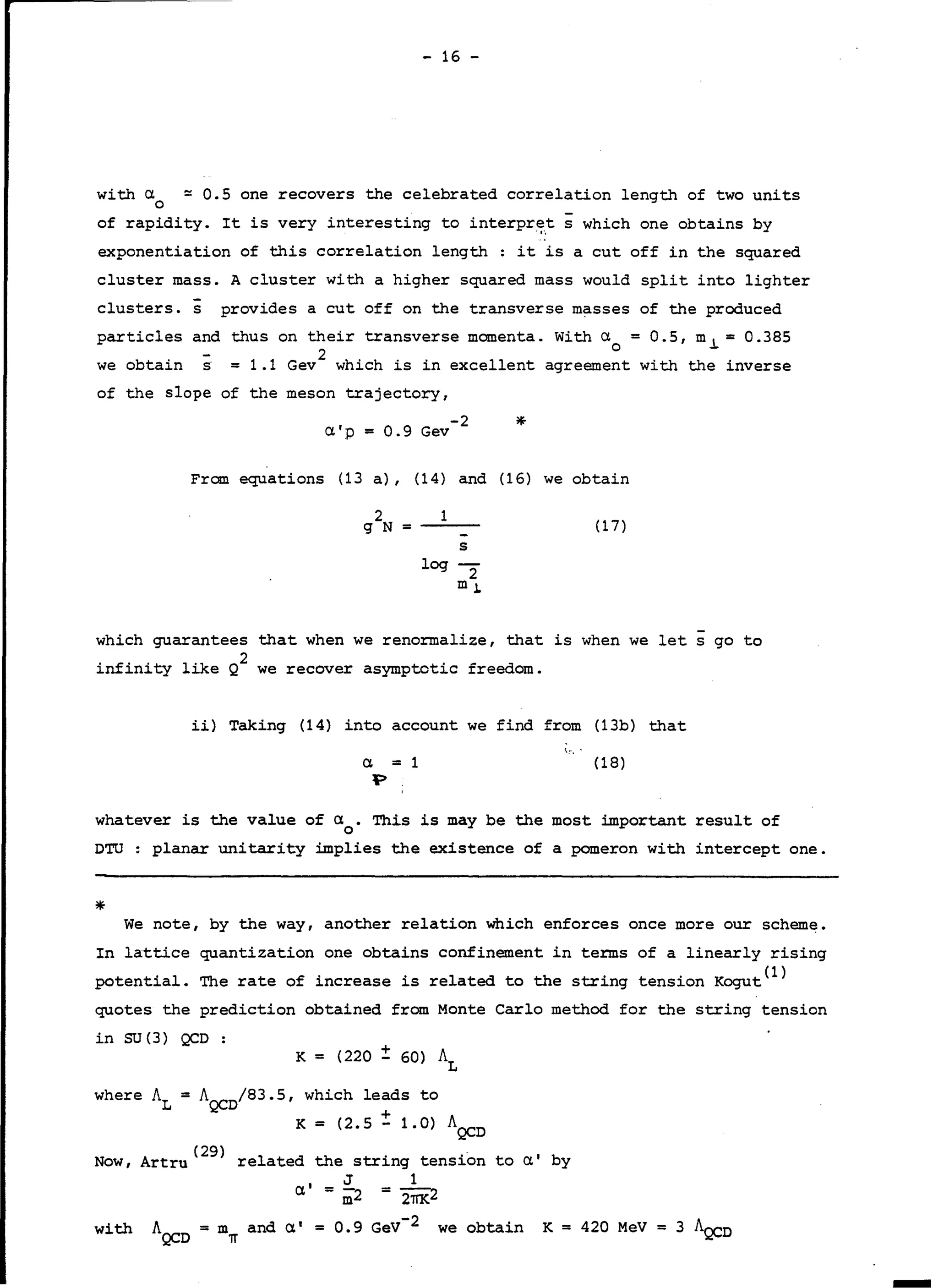


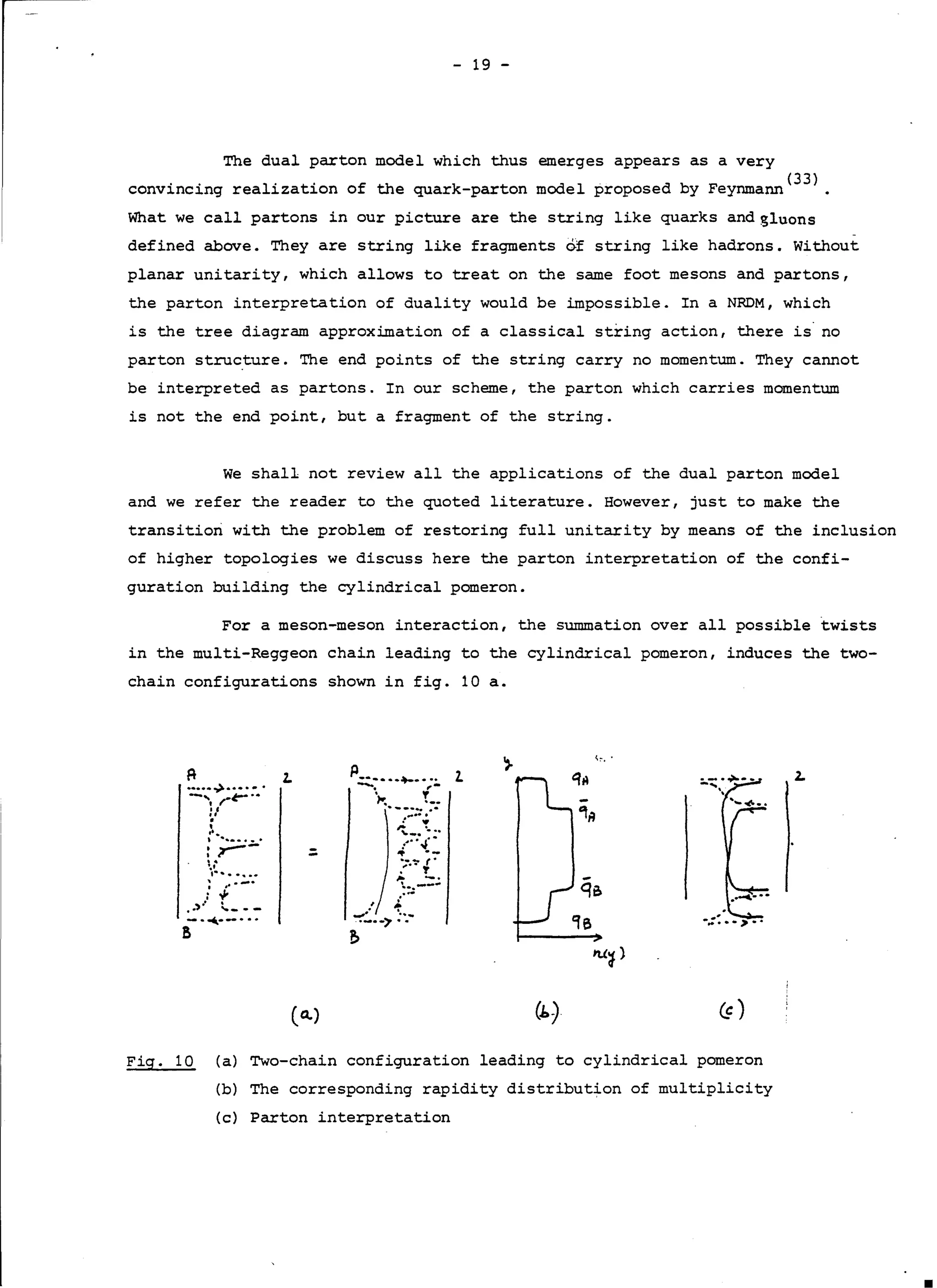
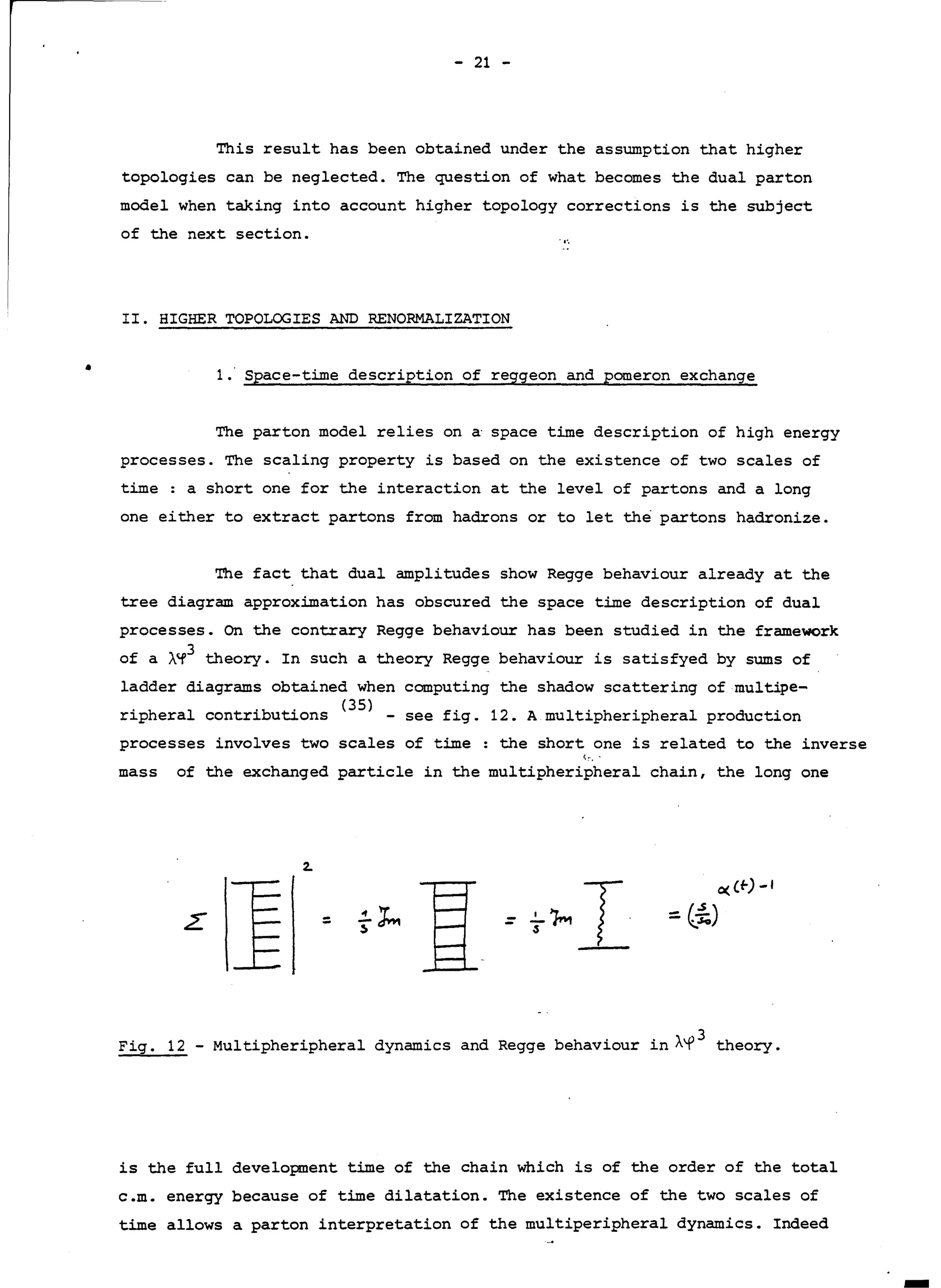

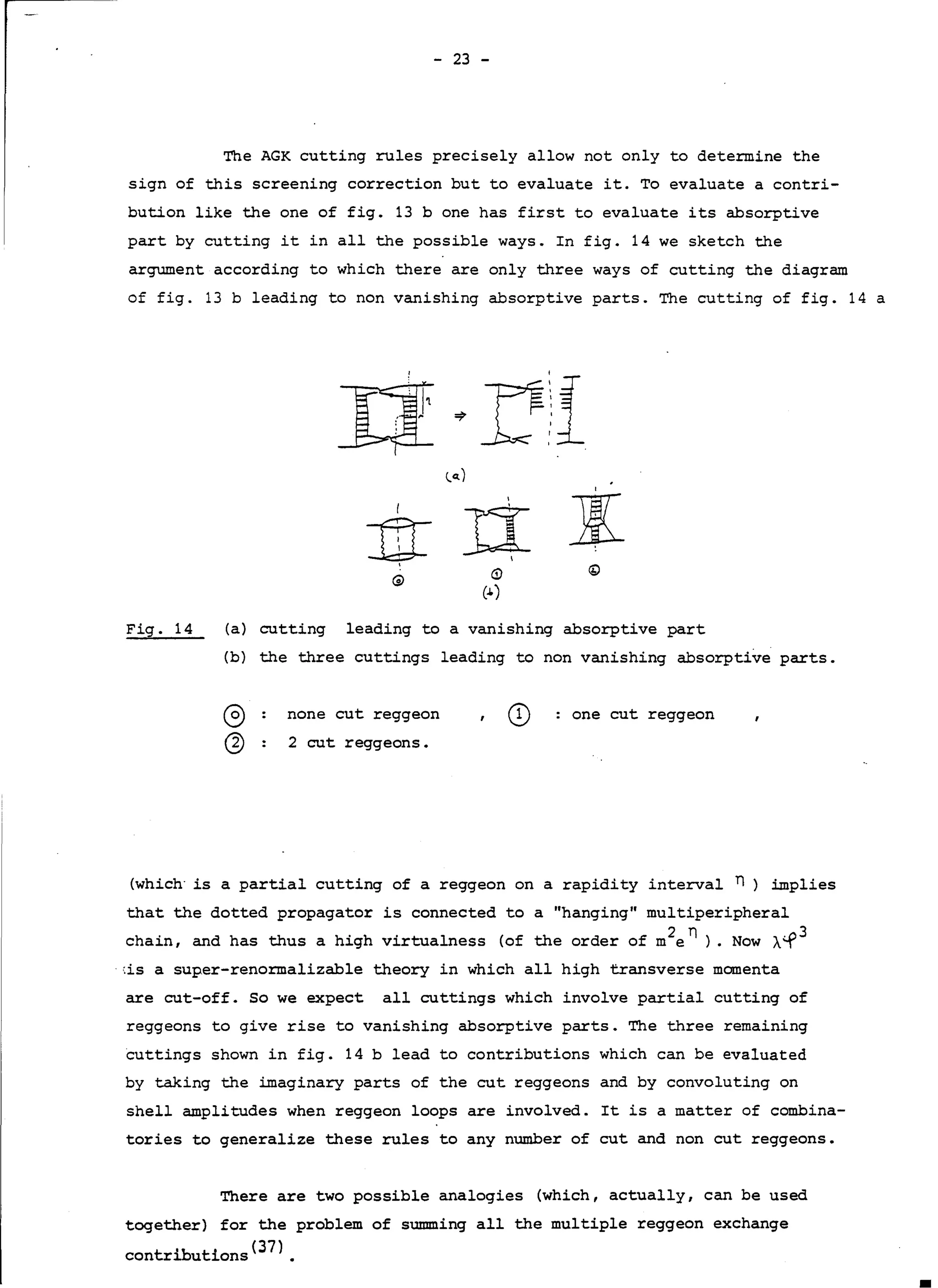
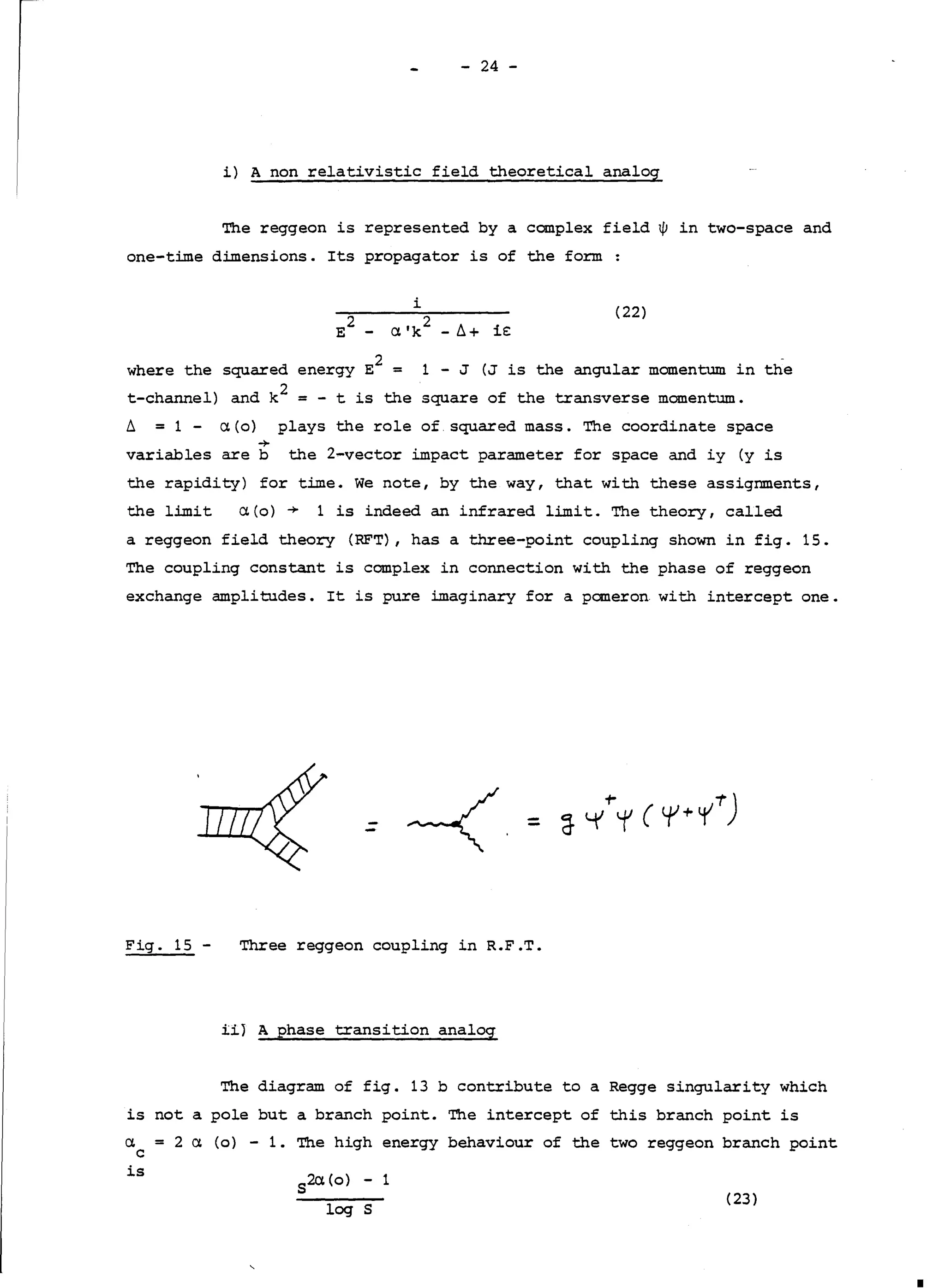

![- 26 -
By using together the two analogies which we have just sketched
one may hope to use some renorinalization inspired techniques to compute
"critical exponents". In the analogy which we have discussed a critical
exponent would be related to the power of legs in the behaviour of the high
energy total cross section (renormalized pomeron propagator). The hope was
that, thanks to universality properties, this critical exponent is not too
much dependent on the specific properties of the underlying local field
theory.
One must recognize that the outcome of this program is not very
convincing. In our opinion, this is due to the fact that, despite univer-
sality, the À~ mode! is a too crude mode!. It is not strictly renormalizable
but super renormalizable; there are no partons ; there is no bare pcmeron
with intercept one. We thus come back to the discussion of the topological
expansion of QCD.
3. DTU as a reggeon-pomeron calculus
In contradistinction with the Àf'3 model, our approach has good
chances to lead to interesting results since the underlying local field
theory, i.e. QCD , is strictly renormalizable, since there are hadrons
and partons, and since the bare pcmeron émergës, in a natural way, with
intercept equal to one.
The cylindrical topology of the bare pcmeron allows to understand
why the summation over handles is equivalent to the summation over all
multiple paneron contributions. In fig. 18 we show how an interference
which"is neglected in DTU is recovered as a final state interaction correction •
. (.
][
Fig. 18 (a} an interference leading to a one handle topology
(b} final state interaction through one cylindrical pomeron exchange
leading to
(c) a one handle topology;when summing over all internal loops, topo-
logies (a) and (c) are equivalent](https://image.slidesharecdn.com/criticalhadronization-190830091514/75/Critical-hadronization-27-2048.jpg)
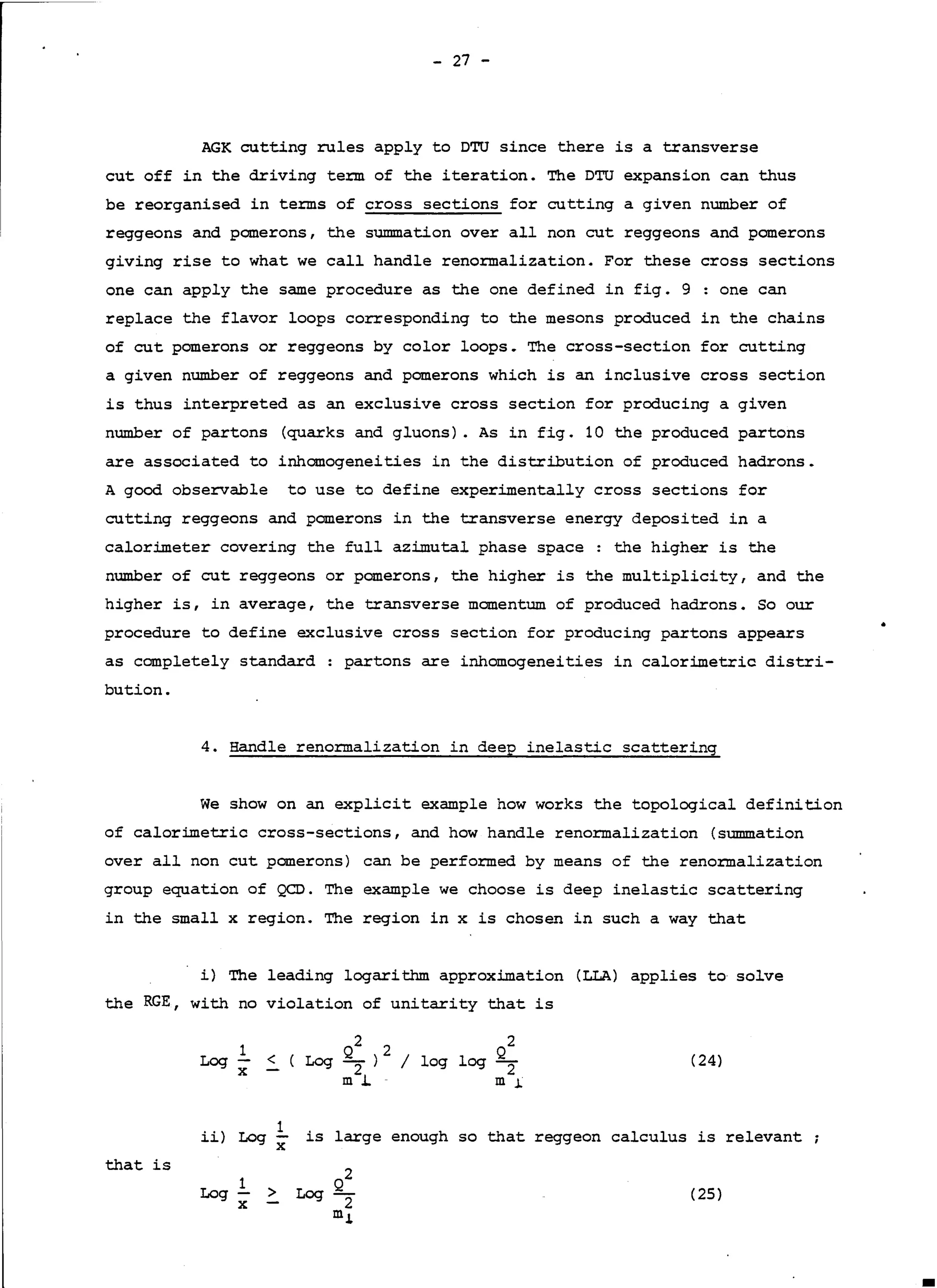










![- 38 -
The idea is thus to perform a paneron calculus in D.I.S. on a
nuclear target anito use our renormalization group approach to sum it up.
For the sake of simplicity we assume that the profile function T(b) is a
flat function. We thus introduce the normalized n nucleon cluster distri-
bution:
A-n
P(n,A) = (A) P(A)n-l r1 - P(A)]
n -
(40)
which satisfies
A
~
n=l
n P(n,A) = A (41)
provided that
0 < P (A) < 1 {42)
with P(n,A) we can write the structure function of the nucleus A as
A
= I:
n=l
n 2
P{n,A) F2 (x,Q) (43)
n · th f · f th 1 1 <45)where F
2
is e structure unction o en nue eon c uster
For a non singlet quark F~,NS is constrained by
f (44)
so, from eq. 41, we obtain trivially
A
dx F2,NS
2
(x , Q ) = 3A (45)
0
The EMC effect is to be found in the n dependence of P(n,A) and of F~(x,Q
2
).
i) The n dependence of P (n,A) is given by eq. 40. We constrain
P(A) by the fact that the average number of wounded nucleons vis of the
same order as in hadron-nucleus collisions
A
V = <n > = ~
n=l
2
n
A
P(n,A) = 1 + (A-1) P(A) (46)
We take
V = with À
(43)
between 0.7 and 1.0](https://image.slidesharecdn.com/criticalhadronization-190830091514/75/Critical-hadronization-39-2048.jpg)



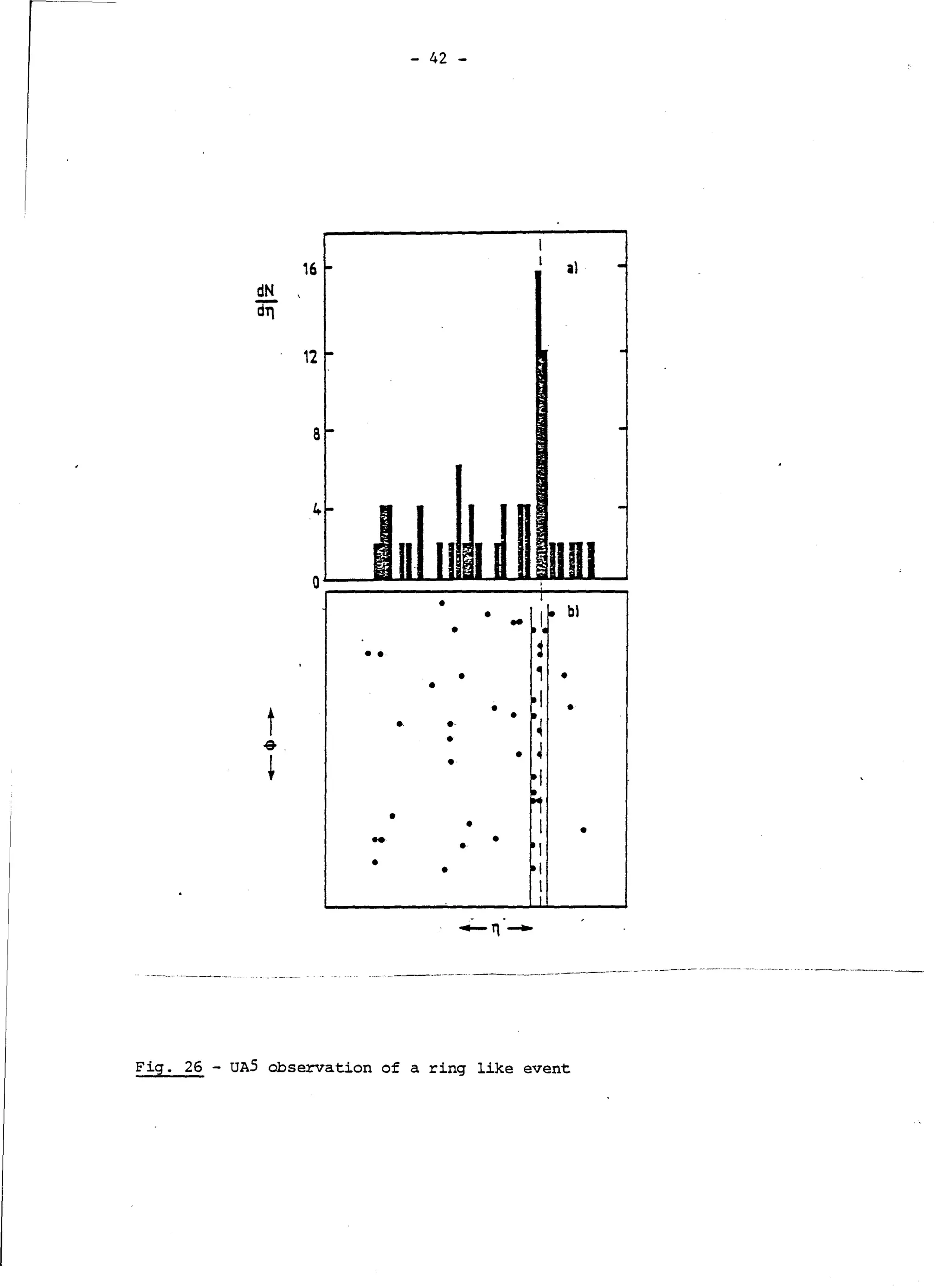

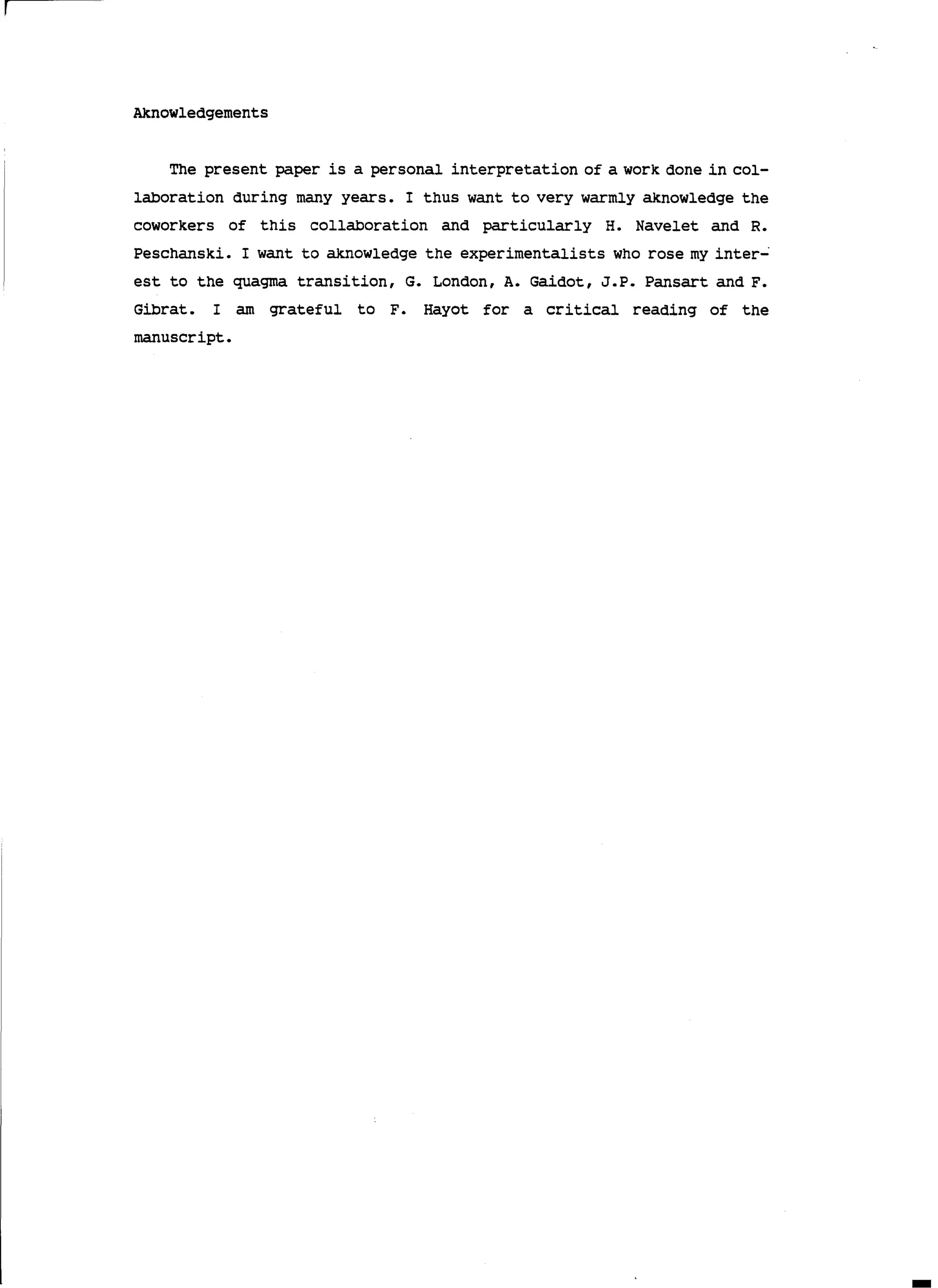
![..
REFERENCES
[1] J.B. Kogut, Rev. Mad. Phys. 55, 775 (1983).
[2] E. Brezin, 21st International Conference on High Energy Physics,
Paris 1982 (Editors : P. Petiau, M. Porneuf) p. C3-743.
[3] H. satz, New states of matter, International Conference on
Nucleus-nucleus, Michigan State University, 1982.
Michigan State University, 1982.
[4] M. Jacob "Expectations for new states of matter", Invited talk
presented at "Quark Matter '83", Brookhaven National laboratory,
September 1983, CERN preprint TH-3728.
[5] Yu. L. Dokshitzer, D.I. Dyakonov anè S.I. Troyan,
Physics Report 58, 269 (1980).
[5] L.V. Gribov, E.M. Levin and M.G. Ryskin,
Physics Report 100, 1 (1983).
[7] A. Bassetto, M. Ciafaloni and G. Marchesini,
Physics Report'100, 201 (1983).
[8] M. Bishari, G. Cohen-Tannoudji, H. Navelet, R. Peschanski,
z. Phys. C - Particles and Fields 14, 7 (1982).
[9] G.F. Chew, c. Rozenzweig,
Physics Report 41C, 263 (1978).
[10] A. capella and J. Tran Thanh Van, Mariand Morkshop on Antiproton
proton physics and W discovery, La Plagne 1983
(Editions Frontières) p.179.
[11] A.B. Kaidalov, JETP Letters 32, 494 (1980).
[12] J. Scherk, Rev. Mad. Phys. 47, 123 (1975).
[13] G 't Hooft, Nucl. Physics B72, 461 (1974).
[14] V.A. Abramowski, V.N. Gribov and o.v. Kanchelli,
Soviet J. Nucl. Physics 18, 308 (1974).
[15] G. Cohen-Tannoudji, A. Mantrach, H. Navelet and R. Peschanski,
Phys. Rev. D28, 1628 (1983).
[16] G. Cohen-Tannoudji and H. Navelet, Proceedings of the warsaw
Symposium on Elementary Particle Physics, 547 (1983).
[17] G. Veneziano, Nucl. Physics B74, 207 (1974).](https://image.slidesharecdn.com/criticalhadronization-190830091514/75/Critical-hadronization-46-2048.jpg)
![[18] G. Veneziano, Nuovo Cimente 75A, 190 (1968).
[19] H.M. Chan and J. Patton, Nucl. Physics BlO, 519 (1969).
[20] P. Ra.rnond, Phys. Rev. D3, 190 (1971).
[21] Dual Theory, Physics Report reprint, Vol.1, ed. M. Jacob (1974).
[22] A.L. Bugry, G. Cohen-Tannoudji, L.L. Jenkovzsky and N.A. Kobylinski,
Fortschritte der Physik 21, 427 (1973).
[23] C. Lovelace, Proc. Roy. Soc. A 318, 321 (1970).
[24] S.L. Adler and R.F. Dashen, current Algebras (Benjamin, NY 1968).
[25] G. Parisi and R. Petronzio, Phys. Letters 94B, 51 (1980).
[26] B. Cox, 21st International Conference on High Energy physics,
Paris 1982 (Editors P. Petiau and M. Porneuf) p.C3-140.
[27] G.P. Lepage, 1983 International Symposium on lepton and photon
interactions at high energy, Cornell (1983) p.565.
[28] G.F. Chew and A. Pignotti, Phys. Rev. 176, 2112 (1968).
[29] X. Artru, Physics Report 97, 147 (1983).
[30] H.M. Chan, J. E. Paton and Tsou Sheung Tsun,
xuci , Physics B,86, 479 ( 1975) •
[31] M. Bishari, Phys. Letters 59B, 461 (1975).
[32] G. COhen-Tannoudji, A. El Hassouni, J. Kalinowski,
and R. Peschanksi, Phys. Rev. D19, 3397 (1979).
[33] R.P. Feynman, Photon hadron interactions (Benjamin, NY 1972).
[34] G. Cohen-Tannoudji, A. El Hassouni, J. Kalinowski, o. Napoly
and R. Peschanski, Phys. Rev. D21, 2699 (1980).
[35] D. Amati, S. Fubini and A. Stanghellini, Nuovo Cimente 26,896 (1962).
[36] G. Cohen-Tannoudji, A. Morel and H. Navelet,
Nuovo Cimente 48, 1075 (1967).
[37] R. savit, Phenomenology of hadronic structure, proceedings of the
Xth Rencontre de Moriond, edited by J. Tran Thanh van, 101 (1975).
[38] G. Altarelli, Physics Report 81, 1 (1982).](https://image.slidesharecdn.com/criticalhadronization-190830091514/75/Critical-hadronization-47-2048.jpg)
![•
[39] K.G. Wilson, Rev. Mod. Phys. 55, 583 (1983).
[40] UA4 Collaboration, C. Vanini's talk presented at the XIXth
Rencontre de Moriond (1984).
[41] A. capella and J. Tran Thanh Van, z. Phys. C18, 85 (1983).
[42] G. Arnison et al. (UAl Collaboration), preprint CERN EP/82-12.
[43] A. capella and A. Krzywicki, Phys. Rev. D18, 3357 (1978).
[44] J.J. Aubert et al. (EMC Collaboration), Phys. Letters 123B, 113 (1983).
[45] G. Berlad, A. Dar and G. Eilam, Phys. Rev. D22, 1547 (1980).
[46] F. Eisele, 21st International Conference on High Energy Physics,
Paris 1982 (Editors: P. Petiau and M. Porneuf) p.C3-337.
[47] W. Willis, International Conference on high energy physics,
Lisbon 1981, p. 1105.
[48] I.M. Dremin, Moriond Workshop on Antiproton proton physics
and the W discovery, Editions Frontières, 379 (1983).
[49] J. Rushbrooke, Contribution to the Berkeley Workshop (1983), UA5.
[50] A. capella, J. Kwiecinski and J. Tran Thanh Van,
Phys. Letters 108B, 347 (1982).](https://image.slidesharecdn.com/criticalhadronization-190830091514/75/Critical-hadronization-48-2048.jpg)